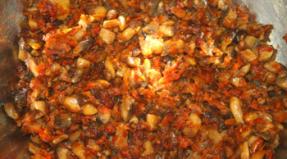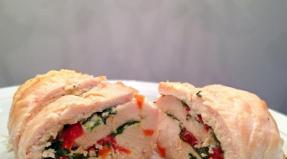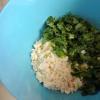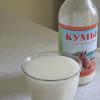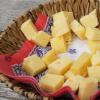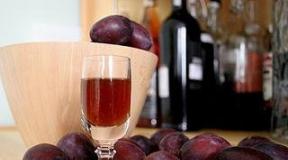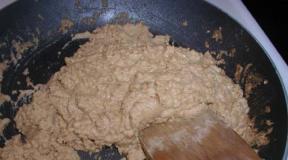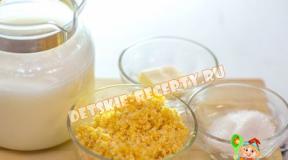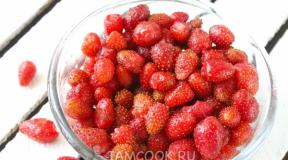Pickled horse mackerel at home. Black Sea horse mackerel: sluggish correctly
If the question is what to cook a sort of original in a quick and, at the same time, inexpensive and not laborious, then salted horse mackerel from the Black Sea is what you need. When choosing fish for salting, it must be borne in mind that an excellent dish is not obtained from each of its types, but only a certain one with specific properties, namely, the ability to “ripen”. These are, first of all, herring, salmon, whitefish, notothenia, mackerel, anchovy and scad families of fish.
When salting fish, 3 groups of finished products are distinguished in accordance with the mass fraction of salt in the total output. This is how slightly salted, medium salted and strongly salted fish are distinguished, where the salt content is 6-10%, 10-14% and over 14%, respectively.
The use of large non-iodized salt in the preparation of spicy salting of fish ensures the removal of excess moisture from it. Thus, the product is not imparted with any taste or its conservation, and moisture is drawn out of the fish due to the slower dissolution of coarse salt crystals at low temperatures compared to fine salt, which, when dissolved, immediately provides a quick salting of the fish without dehydration. The brine, which is formed in the process of salting from a solution of salt and natural juice of fish pulp, is called brine. The most suitable container for salting horse mackerel is stainless, enameled or durable plastic dishes.
Mackerel must be washed with cold water before salting. Then it is necessary to leave it to ensure moisture drains, but it is important not to overdry the fish, otherwise it will lose its taste. Next, the fish is folded belly up into a container prepared for salting and sprinkled with salt in layers. Salt consumption is 1 kg per 10 kg of fish. The use of a mixture of salt and sugar for salting at the rate of 25-30 g per kilogram of salt gives horse mackerel an unusually delicate taste.
Upon completion of the laying of the horse mackerel, it is covered with a mixture of salt, sugar, preservative and spices and vinegar is added in doses. The use of vinegar speeds up the process of salting the fish and lightens its flesh. Then the container with the fish is placed under oppression and placed in a cold place where the temperature should not exceed 3 - 8 degrees Celsius. As oppression, it is best to use lime or aspen boards, made in the form of circles from a single piece of wood or from sold bars. The use of these types of wood is due to their resistance to deformation in a salty environment and the absence of resin emissions, as well as tannins.
The Black Sea horse mackerel Trachurus mediterraneus ponticus is a small subspecies of the Mediterranean Trachurus mediterraneus.
This is the Black Sea a few minutes after the catch near Gurzuf.
Photo: http://egenika.gallery.ru/
The decrease in the size of individuals in a part of the population that, in one way or another, got into a reservoir with a smaller volume of water - albeit a rather large one in itself - is practically a biological law.
Similarly, the Mediterranean anchovy was crushed in the Black and Azov Seas to anchovies, the Atlantic herring in the Baltic turned into a subspecies of Salak, and the smelt, which got stuck after they laced off from the Baltic Sea, in Ladoga and Onega degenerated into a smelt.
At the same time, new subspecies differ from the original species in taste - due to the different composition of the water of the reservoir that gave them shelter and the differences in the species composition of the food base in it.
Having settled in the Mediterranean Sea from the Atlantic some thousands of years ago, and then having mastered the Black Sea, horse mackerel has already reached Moscow. In size, it still does not lose in the capital, but in comparison with freshly caught quality, it is quite obvious 
the lens is clouded - and ideally the eyes should be clear, as in the first photo.
But I fell in love with her so much when I lived in the Crimea - in that one, still Ukrainian, and therefore cosmopolitanly common - and I miss her so much that I bought one with a clouded lens.
Moreover, at first, after the heroic annexation of the peninsula, horse mackerel was offered in the capital for 1 thousand rubles / kg - and now I saw it on the market on Prazhskaya for 250 rubles: Muscovites probably didn’t understand it, didn’t taste it, but now they catch it in Crimea, regardless of any norms of the maximum allowable withdrawal, and this overfishing needs to be sold somewhere.
The intestines of the horse mackerel turned out to be empty, so I didn’t gut the fish - and didn’t even rip off the tail shields 
although for showiness it would be necessary.
So, without scraping the tail stalks, and put it on a well-heated pan 
only now I even overheated the oil - and the delicate skin immediately burst.
But this is even good: because it is better that these prickly shields do not get into the mouth - so the skin would still have to be removed. In general, in any case, a buzz 
But no matter how I was in a hurry to eat fried horse mackerel with cold beer, I immediately put aside some of it - and salted it with dry salt Extra 
I put the carcasses crosswise in an enameled container, and a bag - or even two - so that later the pan is easier to wash.
And a day later he doused it with a stream of cold water under the tap: he washed away the remaining salt 
and opened up the back.
It turned out just great 
Some of the lightly salted food was eaten right away, and a few pieces dried up: hung inside the refrigerator on unbent paper clips, clinging to the bars of the shelves. Hanging for 6 days. He took off the hanging ones - but not yet dried: the skin is dry and taut, and the flesh inside is elastic 
Just before you eat - and admire - you need to remove the skin. Pick up with a knife blade at the base of the dorsal fin - and remove first from one side, and then from the other.
And if you don’t remove it, with the shields that stretch along the sideline, you can not only scratch your lips, hurt your throat, but also just choke 
Muscles are shedding fat 
It's incredibly tasty, I haven't been so happy for a long time.
Only now I salted it by eye - therefore, I won’t tell you how much salt to put on 1 kg of fish.
It needs to be lightly salted.
Oh, and one more thing: beer, wine and vodka are optional - although they are usually fine on their own - and I really like lightly salted fish with sweet black coffee and a hot egg in a bag.
And these are the shields on the caudal peduncle that I wrote about above - which cannot be eaten, and they must be torn off 
This is an important systematic feature of the family. Caranx Carangidae /syn. Horse mackerels /, which include horse mackerels, and every time I am surprised how people manage not to notice them - and confuse horse mackerel with a completely obviously and fundamentally different smooth-sided mackerel.
Well, if you have already been brought to the Crimea, try both: it is clear that there, freshly caught, they are even tastier than those brought to Moscow.
The Black Sea horse mackerel belongs to the order Perciformes (Perciformes) of the horse mackerel family. Due to the very special structure and arrangement of its scales, this fish is very convenient to clean. The fish has a small size, which also makes it convenient for processing at home. Gourmets will certainly enjoy its special aroma and slightly specific spicy taste.
Choose fish for drying of the same size, which should not exceed 15 cm. To begin with, the fish is salted, and then dried. For these purposes, medium-fat sea and low-fat fish are usually used. Dry salting should be used to prepare the fish for smoking. To remove excess moisture from the fish, before salting it, it is necessary to rinse and dry the horse mackerel.
After that, dishes for salting are selected. An ordinary ten-liter pan may be suitable for this. This pot fits well in the fridge. The bottom of the pan is sprinkled with coarse salt. Salt should not be iodized. The salt layer should be 0.5 mm. The fish is laid out in layers, each layer of fish is sprinkled with salt. You should not lay out the fish to the top edge, be sure to leave a distance of 5 cm to the top. The top layer of fish is sprinkled with salt. The layer thickness should be approximately 1.0 - 1.5 cm.
On top of the last layer of horse mackerel, it is necessary to put a plank (and, if possible, a circle) made of wood. For these purposes, you can use a plate or a lid from a small saucepan. A load is placed on the circle. Its weight should be at least 10-15% of the weight of the fish in the pan. After 3-4 hours, the fish begins to secrete intercellular juice under the influence of salt. It is at this point that the pan is placed in the refrigerator. The temperature in the refrigerator should be + 3-5 degrees. The pan should stay in the refrigerator for 2-3 days. After salting, the fish is washed under a tap. The water must be cold. You can wash the fish in a colander, which is fixed over the sink to drain the remaining water.
Many do not know how to properly hang a fish, by the tail or by the head. It is best to hang the fish by the lower jaw. To do this, use a regular paper clip. The clip needs to be straightened. However, there are no clear rules for hanging fish, everyone chooses a method convenient for him. It is better to hang fish on the balcony. The balcony must be necessarily closed so that flies do not sit on the fish, dust does not fly. On the balcony, air circulation will be much better than in the room.
You can also hang fish on hangers through the eye. If you have to dry the fish on the street, wipe it with gauze soaked in a solution of 9% vinegar. This is necessary to protect the horse mackerel from flies. After 4-5 days the fish will be ready. Humidity should be no more than 80%, and the temperature should be 20-26 degrees.

Add salt, sugar and a bay leaf broken into several pieces into the container to the horse mackerel. Stir and leave for a day, during which time the fish will be salted well.

The next day, we prepare the marinade - for this we boil a liter of water, add 2 tablespoons of salt, one - sugar and sweet peas. Let the marinade cool, add 3 tablespoons of vinegar to it.

We clean the onion and cut it into thin half rings.


We spread the horse mackerel in a container for pickling (I have a plastic box with a lid from mayonnaise), add onions, fill the whole thing with marinade.


We leave the fish for 2-3 days to marinate (the original recipe indicated 10 days for marinating, but I thought that this fish was tried a lot on the 3rd day, it was absolutely ready).

We throw back the Black Sea horse mackerel of spicy salting in a colander, fill it with unrefined sunflower oil and proceed to the meal.

Stavridka turned out very tasty, with potatoes it was just a fairy tale.

Bon Appetit!
Cooking time: PT00H30M 30 min.
Do you know that the new generation Honda Civic Type-R will accelerate to 270 km/h? If not, then I recommend referring to the review of a large automotive portal, which is presented at http://www.motobikecar.ru/2015/02/honda-civic-type-r-270.htmlTo begin with, I will give you a recipe for dried (correctly dried) Black Sea horse mackerel, because due to its small size, the absence of falling large scales, marine origin and belonging to the Perciformes order, it has a body that is convenient for cleaning from scales, a specific spicy taste and special aroma. According to “Commodity Research of Foodstuffs” (N.D. Kudentsov, Publishing House “Economics”, Moscow, 1968, p. 115), “dried fish is called fish that has previously undergone the process of salting by the chilled brine method or the dry salting method, and then dried on hangers to remove moisture to the state of readiness at a humidity of not more than 38%”.
For drying, it is better to take the Black Sea horse mackerel of approximately the same size, at least 10 and up to 15 cm long. For salting and subsequent drying of low-fat and medium-fat marine fish of pelagic species, it is better to use the dry salting method.
First, the horse mackerel must be washed and dried to remove excess moisture. Then you should choose dishes for salting.
Personally, I like ordinary household ten-liter pots that can be placed without any problems in the refrigerator. Before salting, it is necessary to pour a layer of coarsely ground salt (necessarily non-iodized) of 0.5 mm on the bottom of the pan (or any other utensil). Next, you should lay out the horse mackerel in layers, abundantly sprinkling each layer of fish with salt, so that a distance of about 5 cm remains to the upper edge of the container.
The top layer of fish is also sprinkled with salt 1.0 - 1.5 cm thick. Salts must be used for dry salting of horse mackerel, at least 12-15% by weight of the fish. A wooden circle (a plate, an enameled lid, etc.) is placed on top of the last layer of horse mackerel, on which oppression (load) weighing at least 10-15% of the mass of the fish is placed.
After about 3-4 hours, under the influence of salt, natural brine (intercellular juice containing proteins and minerals) begins to stand out from the fish.
It is at the very moment that the dishes with fish should be placed in the refrigerator with a temperature regime of + 3-5 degrees for 2-3 days. After salting, the horse mackerel should be carefully washed under running cold water, removing excess brine (you can do this in a large colander, and then leave the fish in it to drain the water).
The question of how to hook the horse mackerel correctly, by the tail or by the head, is decided arbitrarily. For example, I like to hang horse mackerel by hooking it by the lower jaw with an ordinary paper clip on the balcony of a high-rise building (6-10 floors), where there is good and stable air circulation.
You can also hang horse mackerel on hangers with flyers in the courtyard of a private house, having previously determined where the breeze constantly blows.
In the latter version, I categorically recommend that you cover the horse mackerel hooked through the eye with gauze soaked in 9% vinegar to protect against cheese flies. After 4-5 days, at a temperature of 20-26 degrees and a humidity of not more than 80%, the horse mackerel is well dried. The readiness of horse mackerel is determined as follows: the back of the finished dried fish is shrunken, the meat is resiliently rigid, on the cut it has an even grayish-yellow color, and the caviar is orange-red.
Dried horse mackerel I like to use exclusively according to the Astrakhan classic method, dipping its peeled pulp into a bowl filled with mustard or unrefined sunflower oil.
